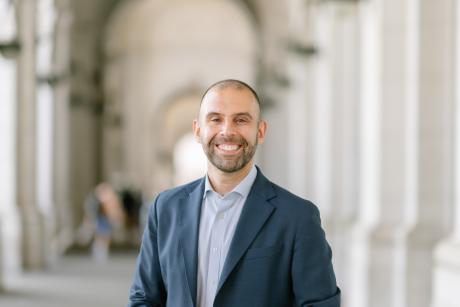
William Pan (far right) and Ben Zaitchik talk with government stakeholders in Peru at their annual malaria meeting.
Published March 20, 2019, last updated on March 31, 2020 under Research News
Peru’s malaria surveillance and control program is about to be transformed from a reactive system to a proactive one, thanks to a NASA-funded tool that can predict up to 12 weeks in advance where outbreaks are likely to occur. The early warning system will give public health officials time to take strategic, coordinated actions to prevent the disease.
The new forecasting system—the first of its kind in the world—taps into the long-established relationship between the environment and malaria. Using sophisticated statistical models, it links satellite-generated data such as temperature, precipitation, land use and land cover with malaria transmission to predict the probability of an outbreak.
Public health officials can then use this information to make calculated decisions about how and where to intervene with preventive measures such as distributing and promoting the use of treated bed nets, spraying insecticides, training community health workers and encouraging people to wear long-sleeved shirts and long pants.
William Pan, an associate professor of global environmental health at Duke, and postdoctoral fellow Mark Janko have been working with Ben Zaitchik, an associate professor in the Department of Earth and Planetary Science at Johns Hopkins University, to develop the system, which will launch later this month.
The new system will provide a much-needed upgrade to an aging malaria surveillance program in Peru, where the Amazon rainforest accounts for more than 60 percent of the terrain and is a prime breeding ground for malaria-carrying mosquitoes. Ninety percent of all malaria cases in the western hemisphere occur in the Amazon, and in recent years, malaria has increased more in this region than anywhere else in the world.
The increase followed a period of declining malaria rates between 2006 and 2011, when Latin America benefited from significant malaria control investments by the Global Fund to Fight HIV/AIDS, Tuberculosis and Malaria. In 2010, the Global Fund withdrew this funding from the region, leaving the ministries of health with limited resources to combat the disease.
“One of our primary goals with this system is to enable the Peruvian government to use their malaria control resources more efficiently and effectively, and this early warning system will do just that,” said Janko.
Currently, malaria surveillance in Peru relies on malaria infection data from local clinics. To determine where to deploy resources, public health officials review reports of recent cases by district and compare the data to the mean number of cases over the last six years for that week in that district. This method doesn’t take environmental conditions, which relate directly to malaria transmissions, into consideration. It reveals when an outbreak has occurred, but not when one will occur.
Another challenge is that public health officials track malaria cases based on where people receive their diagnosis, but often people contract malaria in one district and visit a clinic in another, which may be as far as tens or even hundreds of kilometers away. As a result, what appears to be an outbreak in one district may not accurately reflect where the concentration of malaria-carrying mosquitoes is located.
One way the new system addresses this issue is to divide the 51 districts in Loreto, the region where the researchers are working, into seven areas with common ecological conditions, such as temperature, rainfall, soil moisture, humidity and land cover. These “ecoregions” provide a scientific framework for where malaria-carrying mosquitoes are likely to be breeding.
“In the Peruvian Amazon, ecological conditions can vary significantly within a given district, and some of these variables impact which mosquitoes live where,” said Pan. “In one part of the district, you may not be at risk of malaria, but if you travel 10 kilometers to another part of the district, and enter a different watershed, for example, your risk level may increase drastically.”
In Peru, public health decisions are made at the district level, so the early warning system pairs the ecoregion approach with another statistical model that considers the correlation between districts, preserving the existing operational structure.
In addition to forecasting malaria cases, the early warning system includes the first-ever set of Agent Based Models (ABMs) of malaria transmission. Developed by Francesco Pizzitutti, a former postdoctoral fellow at the Duke Global Health Institute, and Carlos Mena, a professor of geography at Universidad San Francisco de Quito in Ecuador, the ABMs use a computation method to simulate behavior of humans, mosquitoes and the malaria parasite. These simulations enable public health officials to evaluate which combination of interventions would have the most significant impact on reducing malaria.
The research team will run the system for the first few months, working closely with Peru’s Centers for Disease Control and Ministry of Health to fine-tune the system and determine how to best convey the data to key stakeholders. After about six weeks, the team and local public health officials will assess the system’s effectiveness. Ultimately, the team plans to hand off the system to their Peruvian colleagues.
Pan is optimistic that the early warning system will have a powerful impact on Peru. “The Peruvian government is strongly motivated to control malaria, but they haven’t had effective tools to do that,” said Pan. “This system provides a tool that has the potential to steer the country toward elimination or eradication of malaria within ten years.”
And Pan and Janko are already envisioning a broader future for the early warning system. “The system is not only transferrable to other countries, but it would also work for different vector-borne diseases, like Zika or dengue, that are dependent on environmental conditions,” said Janko. According to Pan, the success of a similar system in other countries would depend in part on the extent to which climate and land cover are predictors of malaria in that setting. Currently, the team is exploring opportunities to expand the system across the Amazon basin.
Watch a NASA video about the project.


